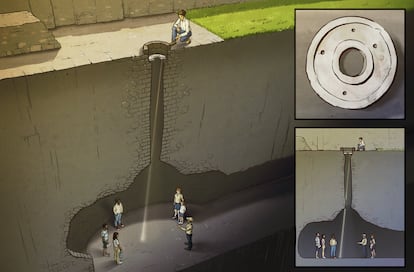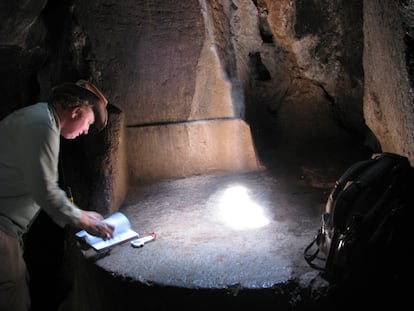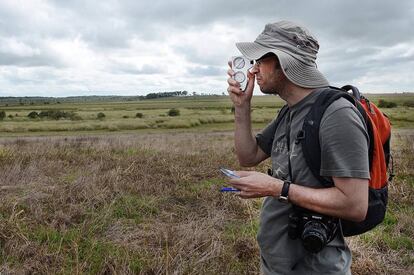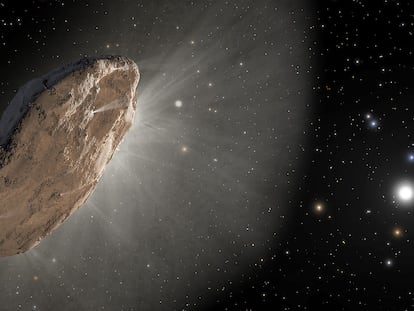From dark constellations to solar observatories: How pre-Hispanic America contemplated the cosmos
For thousands of years, Indigenous groups and pre-Columbian civilizations observed the universe to better understand the world

“The Incas not only saw the kind of constellations that we see, they also saw dark constellations in the black spots of the Milky Way,” says Professor Dr. Steven Gulberg, an astronomer at the University of Oklahoma noted for his studies of astronomical alignments at various Inca archaeological sites in the Andes.
Those dark constellations consist of several giant clouds of interstellar dust and gas blocking light in the center of the galaxy, which can only be seen from the southern hemisphere of the planet. Gulberg recalls how, on one of his expeditions, his Peruvian colleague Carlos Aranibar Huaman used a green laser to point out each constellation, telling its story.
“The procession begins with Mach’acuay, the serpent,” Gulberg recounts. It is followed by Hanp’atu, the toad, and Yutu, the partridge. The most important constellation is Yacana, which consists of two llamas, a mother with her young. At the end of the procession of stars is Michiq, a shepherd who protects the two llamas from Atoq, a fox. The U.S. astronomer admits that, despite having completed a PhD, he had never heard of the dark constellations and that learning their history in the Andes was one of the most special experiences of his life.
For thousands of years, the study of the cosmos has been an integral part of how humans seek to understand the order of their lives and the world. In pre-Hispanic Latin America, observations of the universe allowed different groups to predict climatic changes, develop accurate calendars, and were a source of philosophical, religious, and mythological inspiration.

‘Cerritos de Indios’
The Incas were not the only civilization to see dark constellations in the Milky Way. Some indigenous groups in Uruguay and southern Brazil saw in these starry spots a rhea, the largest flightless bird on the continent. Today, in this area, there are about 3,000 artificial mounds, known as ‘cerritos de indios.’
These are found on plains in humid areas in the south of the continent, which are easily flooded. These hills allowed their builders to protect their dwellings and crops and even provided a place to bury their dead. In them, archaeologists have found human and domestic animal remains, the oldest dating back 5,000 years. These mounds are one of the first human constructions dedicated to astronomical observation in South America.
“What is most striking is that they do not appear scattered any old how, but in groups,” explains Professor César González-García, an astronomer at the Institute of Heritage Sciences in Spain, who has studied the relationship of the Indigenous mounds in South America with the cosmos. They are often in groups of 15 or 20 mounds, lined up one after the other.
González-García explains that one of the things that caught the researchers’ attention is that, “when you stood on top of the mounds, you always saw one of them cutting into the horizon,” which led them to wonder whether these artificial mounds might have “something to do with the sky.”
To answer the question, an interdisciplinary group visited several hills in Uruguay, where they took measurements and found that “almost all of them are looking in the same orientation,” says González-García. This suggests that their orientation is not “fortuitous,” but based on a systematic pattern.
The team found that the cerritos were aligned with the rising of the new moon, before and after the winter solstice, and with the dark constellations of the Milky Way, where the figure of the rhea is seen. Ethnographic research with Indigenous groups in the region such as the Moqoit or the Tob in Argentina, Brazil, and Paraguay confirmed the cultural importance of the rhea.
According to González-García, the mounds helped observers to determine “certain climatic and animal migration cycles,” which allowed these groups to manage time and space thousands of years ago.

Solar Observatories in Mesoamerica
“Practically in all Mesoamerican peoples we are going to find day counters that see the stars and see the sun,” says Professor Rubén Bernardo Morante López of the Universidad Veracruzana, who has been studying pre-Hispanic astronomy in Central America for four decades. For example, the Maya used two 365-day solar calendars, and could even predict eclipses hundreds of years before they occurred.
The Mexican anthropologist explains that these peoples studied the movements of the celestial bodies in order to accurately predict the best times for planting, the rainy seasons, and various ritual aspects.
To develop some of their observations, several groups built subterranean solar observatories. Morante has studied more than 20 observatories throughout Mesoamerica, at archaeological sites such as Chichen Itzá, Monte Albán, Teotihuacan, and Tajín. One of the most important is located in Xochicalco, a Mayan city built around the year 700 A.D. This solar observatory is similar to the telescope used by Galileo Galilei in 1612 to view sunspots, but instead of using lenses to magnify the image of the sun, it uses a disk with five holes and a chimney to project it onto the ground.
When it had the disk at the top, the observatory projected sunlight onto the dome for 105 days, from April 29 to August 13. The light passed through one of the small circles on the first day and more appeared gradually. On only two days of the year, May 14 and July 29, did all five circles appear reflecting sunlight. On the last day, only the opposite circle was projected and, for the rest of the year, the cavern remained in darkness (assuming the disk was placed at the top). Every four years, on April 29, no sunlight was projected onto the vault, which meant that the system automatically added a day to the calendar in leap years.
With the arrival of the conquistadors and the Spanish Inquisition, much of this knowledge was lost. “The first people they are going to persecute are the leaders, those who are spreading the cult of the ancient gods,” explains the Mexican anthropologist. According to Morante, the Spaniards had no interest or the ability to understand Indigenous agriculture, which was regulated by calendars and astronomical observations.
However, this knowledge did not disappear. Several chroniclers sought to document pre-Hispanic knowledge and beliefs. Evidence of their observations exists in archaeological sites and in Indigenous communities throughout the continent. The lives of the various pre-Hispanic Indigenous groups extended to the horizon and the universe. Studying their way of seeing the cosmos allows us to understand the past beyond physical constructions, historical chronicles, or material remains.
For example, in the Andes, the beginning of the planting season in June coincides with the appearance of the Pleiades star cluster in the sky. According to La extirpación de la idolatría en el Perú (The extirpation of idolatry in Peru), written by the Jesuit José de Arriaga in 1621, when the seven sisters appear clear and cloudless in the sixth month of the year, the Incas predicted that it would be a bad year for crops in the empire. However, when Oncoy, the name they gave to this constellation, appeared blurred and surrounded by clouds, it was interpreted as a propitious moment to start cultivating. Climatological and astronomical research has confirmed that there is a relationship between how these stars appear in the sky and the El Niño phenomenon, which reduces rainfall and increases the possibility of drought in the Andes.
Hundreds of years earlier the Incas had found, through the observation of the stars, a way to predict the change of temperatures in the Pacific Ocean and anticipate its effects in the Andes. Today, rural Quechua and Aymara communities continue to use this method of observation.
Sign up for our weekly newsletter to get more English-language news coverage from EL PAÍS USA Edition
Tu suscripción se está usando en otro dispositivo
¿Quieres añadir otro usuario a tu suscripción?
Si continúas leyendo en este dispositivo, no se podrá leer en el otro.
FlechaTu suscripción se está usando en otro dispositivo y solo puedes acceder a EL PAÍS desde un dispositivo a la vez.
Si quieres compartir tu cuenta, cambia tu suscripción a la modalidad Premium, así podrás añadir otro usuario. Cada uno accederá con su propia cuenta de email, lo que os permitirá personalizar vuestra experiencia en EL PAÍS.
¿Tienes una suscripción de empresa? Accede aquí para contratar más cuentas.
En el caso de no saber quién está usando tu cuenta, te recomendamos cambiar tu contraseña aquí.
Si decides continuar compartiendo tu cuenta, este mensaje se mostrará en tu dispositivo y en el de la otra persona que está usando tu cuenta de forma indefinida, afectando a tu experiencia de lectura. Puedes consultar aquí los términos y condiciones de la suscripción digital.
More information
Archived In
Últimas noticias
Imelda Castro, the woman who wants to rule the cartel battleground of Sinaloa
The new victims of the Republican war on Obamacare: Millions hit by soaring health insurance premiums
A country divided on migrant rights: Some US states expand protections while others restrict them
Venezuela authorizes the release of another 87 political prisoners
Most viewed
- David King, chemist: ‘There are scientists studying how to cool the planet; nobody should stop these experiments from happening’
- Reinhard Genzel, Nobel laureate in physics: ‘One-minute videos will never give you the truth’
- Oona Chaplin: ‘I told James Cameron that I was living in a treehouse and starting a permaculture project with a friend’
- Sinaloa Cartel war is taking its toll on Los Chapitos
- The Interoceanic Train, the Mexican alternative to the Panama Canal










































